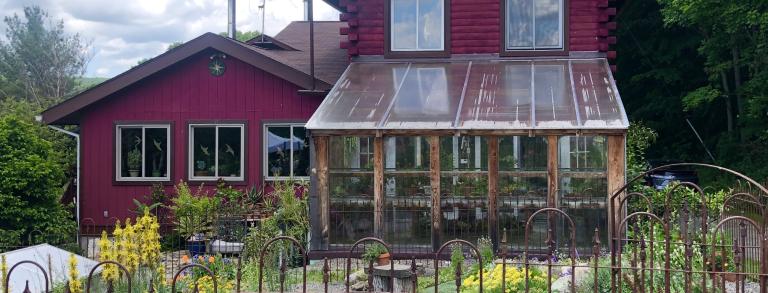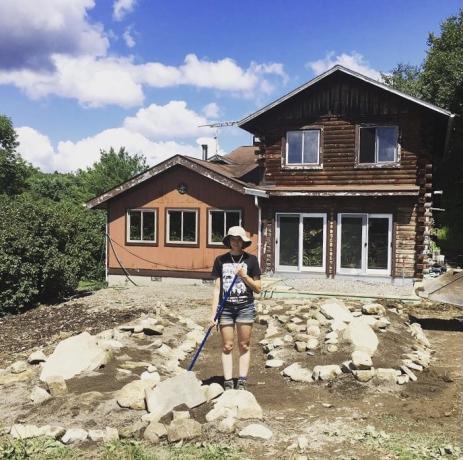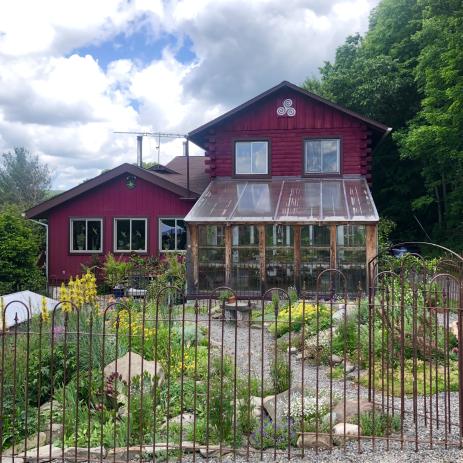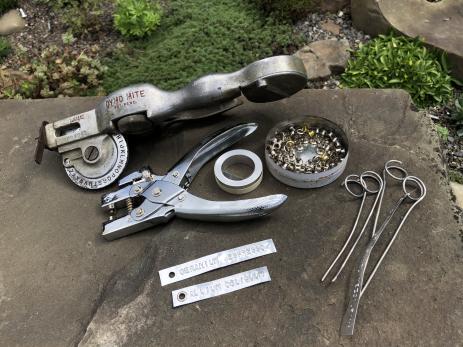Sedum was my gateway genus to rock gardening. In high school, I spent a few summers working at a green roof nursery owned by some family friends. Long hours planting and weeding stonecrop-filled modules gave me an appreciation for those hardy, water-wise plants. Planted en masse, they created a glowing tapestry of yellow, pink, white, and green that defied the summer heat and winter cold. I went home with pockets full of cuttings, which Mom allowed me to plant in a rocky section of the flower garden. In 2017, my parents built a small conservatory to overwinter tropical and succulent mother plants. The construction left the front lawn torn up and dotted with piles of gravelly fill. At my parents’ suggestion, I jumped at the chance to create rock garden version 2.0.
As it happened, my former employers had just sold the green roof nursery and were looking for a way to unload several large “Super Saks” of green roof media. This blend of expanded shale and compost was the perfect base for the new rock garden. Faced with a patch of lawn approximately 30 by 30 feet (9m x 9m), I drew a rough blueprint with a curved path moving through the square at a diagonal. The bones of the two resulting beds were formed from boulders that had been excavated from our rocky fields over the years. I directed the placement and Dad nudged them into place with a skid steer. The beds are simple mounds of fill covered with expanded shale medium and dotted with rocks – “plum puddings” à la Farrer, though I use the term affectionately! Smaller rocks are piled and stacked along the edges, forming a loose stone wall. In year two, I added another bed along the west side, filling it with the last of the green roof medium. In 2020, the rock garden crept further west with the addition of a sand-filled cold frame built by my dad. It is a wooden structure with a polycarbonate lid that can be propped up in warm weather. It holds about two tons of builder’s sand obtained from a neighbor’s sand and gravel pit. It has proven very useful for overwintering plants that are on the edge of hardiness and/or dislike winter wet. I sink terracotta pots in one half and plant directly in the other. The latest addition to the rock garden has been an assortment of homemade hypertufa troughs. They are displayed at the edge of the rock garden in summer and overwintered in an unheated greenhouse.
Climate and Plant Selection
Our farm in Berkshire, New York, is on a west-facing hill in a chilly valley microclimate. We experience lows of -20°F (-29°C) in the winter (USDA zone 5A) and highs in the high 90s F (mid 30s C) in the summer. If we’re lucky, we have consistent snow cover throughout the winter, but it is not uncommon to go through a few freeze-thaw cycles that wreak havoc on finicky alpines. I generally do not water the main garden, except occasionally during the increasingly frequent summer droughts. As a result, anything that gets planted must be tough! The expanded shale medium is fast-draining and low in nutrients. Some parts are very shallow (especially near the edges) and others have up to 3 feet (0.9 m) of shale and fill. The garden is bordered by forest to the east and the house to the north. It starts getting light when the sun creeps over the trees and stays in full sun for the remainder of the day. Since I start many plants from seed, I can plant individuals of a species in many places throughout the garden and see where they thrive. Climate change has made gardening (and farming) much more unpredictable, and some plants are surviving the winters that wouldn’t have made it only decades ago.
As of my last count, the rock garden contains approximately 260 species and cultivars. Many have been started from seed, mainly from the NARGS seed exchange, the Cactus and Succulent Society of America seed depot, saved seed, various companies, and indices semina. My mother is very tolerant of all the “weird” plants I sneak into each round of spring seed starting on the farm. The rock garden wouldn’t be half as interesting without her help coddling all those seedlings. Other plant sources include sales held by the local Adirondack Chapter of NARGS, the Ithaca Farmers Market, and an assortment of regional nurseries. And, of course, some of my favorites have been cuttings and divisions from friends’ gardens.
Labeling
As a botanist and former botanical garden employee, I can’t resist trying to keep track of every plant in the garden. My garden is small enough that this endeavor is (almost) feasible. In addition to maintaining a spreadsheet listing the name, location, and source of each plant, I make garden labels using my beloved DymoMite tapewriter. This is a vintage handheld embosser with a myriad of quirks – I know, for example, that it nearly always fails to advance on the letter “T.” Dymo probably makes a new version, but I’m attached to mine. I emboss the plant names on 0.5-inch (1.27 cm) aluminum tape and use a handheld eyelet tool to reinforce a hole at one end. The resulting label gets slid onto a wire stake with a spiral at one end – rolled 1.5 times around a tube of lip balm, to be precise! The resulting labels sit neatly at ground level and stay in place. They start shiny but dull with age. They may mess with some people’s aesthetics (I have been known to pull some if they are interfering with photographs) but they are subtle enough for me. Above all, they do not decompose or fade with age, failing only when I slice them with my clippers or pull them with weeds. Whenever a plant dies, its label goes in the growing “graveyard” stack in hopes that I get that plant again or it reappears.
Garden Favorites
I could go on and on about plants (there are so many good ones), but here is a smattering that have given me the greatest joy over the past five years, organized roughly by bloom time.
Perennials
Crocus ‘Orange Monarch’ is a charming orange crocus reaches its peak in early April. The flowers are smaller than many other crocus cultivars, but what it lacks in size it makes up for in color and quantity. It is one of the earliest blooms in my garden, preceded only by a few other crocuses and the irises ‘Katherine Hodgkin’ and ‘Harmony’ (also classics!). I originally got mine from K. van Bourgondien in 2018.
Pulmonaria ‘Blue Ensign’ is a reliable true-blue lungwort that blooms April to May. I feed this one every couple of weeks when it is at its peak since the expanded shale is a little lean for its taste. My plant was purchased from Stonecrop Gardens in Cold Spring, New York, during their annual plant sale in 2018.
Iris cristata ‘Eco Bluebird’ has proven remarkably tough, spreading in one of the driest, shallowest, sunniest parts of the garden. It started as a six-inch (15 cm) clump (purchased from Mostardi Nursery of Newtown Square, Pennsylvania, in 2018) and has since expanded to a mat three feet (0.9 m) in diameter. This May, it had hundreds of miniature flowers!
Cytisus ‘Lena’ is a non-invasive hybrid of Cytisus scoparius and C. x dallimorei that produces extraordinary yellow and orange flowers in late May and early June. I picked mine up last year at Petitti’s Garden Center in Strongsville, Ohio.
Aquilegia viridiflora is one is in my top five columbines, and I have a LOT of favorites when it comes to this genus. It has unusual green and chocolate brown flowers and self-seeds lightly. Many of my columbines get mowed down by tiny green caterpillars, but I enjoy them while I can. Other favorites include A. flabellata ‘Nana,’ A. flabellata ‘Alba’, A. grahamii, and A. vulgaris ‘Ruby Port’. I try to get a few new ones from the seed exchange every year.
Gentiana acaulis is obvious. Tiny plant, giant true-blue flowers: what’s not to love? Mine was a division from a friend. It didn’t make as many flowers this year as in the past, so I should probably divide it, but I admit I’m scared. I feed it weekly during the growing season. (See photo on the back cover)
Geum triflorum is a wonderful New York native whose chief attractions are the feathery pink fruit. (See the photo on the front cover) They are incomparable waving above the garden at the golden hour. My plants bloom in mid to late May, with the fruits lasting through June and early July. I started mine from wild-collected seed, but they are readily available, including through the NARGS seed exchange.
Taraxacum pseudoroseum is a dandelion and I love dandelions! Taraxacum is an underappreciated genus with some truly wonderful species. The flowerheads on this one start as a yellow and white “fried egg” with the white soon fading to pink. Other great dandelions include T. faeroense (yellow flowers and dark red foliage), T. albidum (white flowers), T. leucanthum (yellow and white flowers), and T. atrans (narrow foliage, small white flowerheads). Give one a try next time you see one in the seed exchange, just don’t forget to make a sign asking well-meaning visitors not to weed out the dandelions.
Thalictrum alpinum is one of the best thalictrums for a trough. This is a tiny plant (no more than a foot/30 cm in flower) with fine foliage and a cloud of flowers. Mine typically bloom in late April and early May. I originally got the seed from the index seminum of the Lodz Botanic Garden in Poland (2020). Other great thalictrums (but much bigger!) are T. rochebrunianum (clouds of purple flowers) and T. flavum subsp. glaucum (masses of pale yellow flowers).
Asphodeline lutea, aka king’s spear, has been a centerpiece of the garden since the first year. It produces a clump of blue-green rosettes that transform into robust stalks of yellow flowers in early June. Each rosette dies after blooming, but there is a constant supply of pups. I started mine from the 2016-17 NARGS seed exchange.
Opuntia ‘Mulberry Creek’ is a stunning selection with ombre orange-pink petals that bloom in early July. Hardy prickly pears have been a mainstay of the garden ever since I inherited a bunch of wild-type Opuntia humifusa from the green roof nursery. I got my ‘Mulberry Creek’ at Bristol’s Garden Center in Victor, New York, in 2018. Other opuntias that thrive in the garden include O. polyacantha ‘Crystal Tide’ (cream-colored petals with red filaments) and Opuntia fragilis (yellow flowers).
Kniphofia northiae is truly the queen of kniphofias! This plant was the cornerstone of the garden from 2017 to 2021. It produced a cluster of huge rosettes reminiscent of an agave or yucca. It finally bloomed in June 2021 (glory!) only to perish the following winter (sadness). I don’t know if it exhausted itself flowering or merely succumbed to winter wet, but I miss it dearly. I started mine from the 2016-17 seed exchange but haven’t seen it offered since. Contact me if you have seed or know who does!
Helianthemum nummularium ‘Wisley Pink’ is a charming rockrose with glaucus foliage and pastel pink flowers. It put on a real show this June and July, with a new wave of flowers every morning. I shear it lightly after blooming to encourage fresh growth. Mine came from Cayuga Landscape in Ithaca, New York.
Clematis integrifolia is a shrubby clematis that never fails. Every year, it blooms merrily and spectacularly while mom’s large-flowered cultivars succumb to wilt (RIP). The nodding blue flowers start in late May and continue into early July before being replaced by pom-pom fruit. Blue and white forms of this species are commonly available. I also love Clematis tangutica ‘Helios’, a yellow-flowered variety that climbs the fence at one edge of the garden.
Saponaria cypria This “saucy soapwort from Cyprus” merited a feature in the Quarterly a while back, but I’ll also plug it here. It germinated well for me last spring, so I put several in the garden and they exploded with pink flowers in mid-July. The long flowering stems flop, so they are best appreciated while you lie on the path in early evening. I got my seed from the 2020-21 seed exchange.
Symphyotrichum ericoides ‘Snow Flurry’ is an aster that forms a weeping mound of white flowerheads in late September. Like most rock gardens, mine peaks in late spring, so I am always looking for good late-season color. I picked mine up at a plant sale at Cutler Botanic Garden in Binghamton, New York.
Annuals and other monocarpic plants
Cleome hirta is a bushy annual spider flower with sticky foliage and purple flowers with two yellow “eyes.” I generally start it from seed each year because self-sown individuals don’t get very big over our growing season. My seed originally came from the 2018-19 seed exchange and I have been saving my own since.
Linaria aeruginea self-seeds abundantly across the garden, bearing flowers in every shade of purple, orange, and yellow throughout the summer. I let it fill in the gaps between rocks, removing it by the handful where it isn’t wanted. It is another gem from the 2018-19 seed exchange.
Anthyllis vulneraria subsp. coccinea is a weeping biennial legume with brilliant red flowers that peaks in late May. I let it self-seed along the edges of beds, where it spills into the path. Originally from the 2016-17 seed exchange.
Campanula incurva takes three years to bloom (and dies after it does) but the floral display is truly over the top. My happiest plants were grown in pots sunk in the covered, sand-filled cold frame. After two years as rosettes, they erupted into mounds with hundreds of large, pale blue bells. This species is regularly available in the seed exchange.
I moved to Michigan last spring for graduate school, leaving the garden in my mother’s capable hands. She has kept it beautifully and sends me regular bloom updates. I am deeply grateful to her and my dad for enabling my rock garden habit over the years! I look forward to seeing it evolve and grow.




